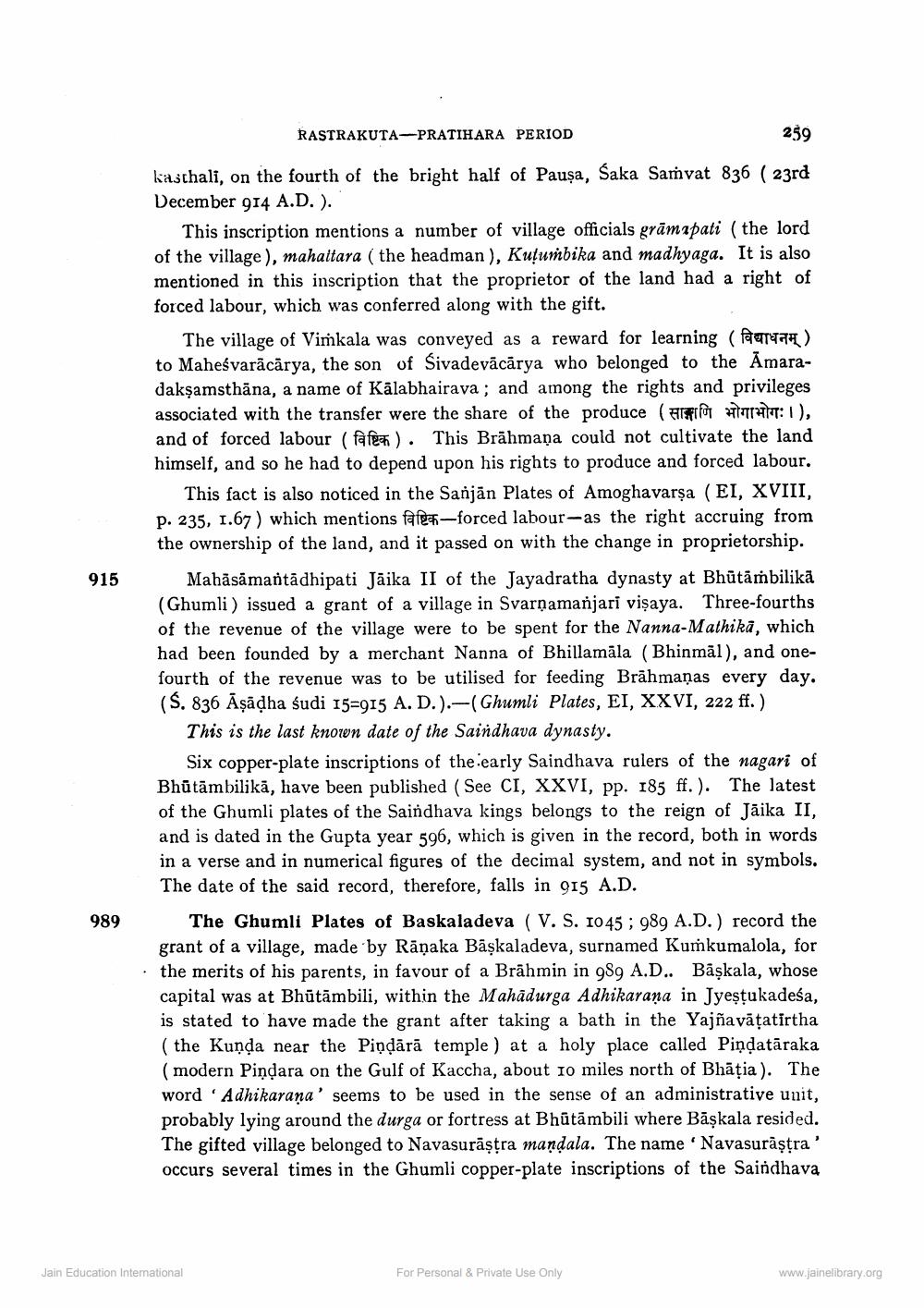________________
RASTRAKUTA-PRATIHARA PERIOD
259
915
kaschali, on the fourth of the bright half of Paușa, Saka Samvat 836 ( 23rd December 914 A.D.).
This inscription mentions a number of village officials grāmapati ( the lord of the village), mahaitara ( the headman), Kuțumbika and madhyaga. It is also mentioned in this inscription that the proprietor of the land had a right of forced labour, which was conferred along with the gift.
The village of Viņkala was conveyed as a reward for learning (alat) to Maheśvarācārya, the son of Sivadevācārya who belonged to the Amaradakşamsthāna, a name of Kālabhairava ; and among the rights and privileges associated with the transfer were the share of the produce ( सामाणि भोगाभोगः । ), and of forced labour (fa feh). This Brāhmaṇa could not cultivate the land himself, and so he had to depend upon his rights to produce and forced labour.
This fact is also noticed in the Sanjān Plates of Amoghavarşa (EI, XVIII, p. 235, 1.67 ) which mentions fafez-forced labour-as the right accruing from the ownership of the land, and it passed on with the change in proprietorship.
Mahäsämantādhipati Jāika II of the Jayadratha dynasty at Bhūtāṁbilikā (Ghumli) issued a grant of a village in Svarṇamanjari vişaya. Three-fourths of the revenue of the village were to be spent for the Nanna-Mathikā, which had been founded by a merchant Nanna of Bhillamāla (Bhinmäl), and onefourth of the revenue was to be utilised for feeding Brāhmaṇas every day. (S. 836 Āsādha sudi 15=915 A. D.).-(Ghumli Plates, EI, XXVI, 222 ff.)
This is the last known date of the Saindhava dynasty.
Six copper-plate inscriptions of the early Saindhava rulers of the nagari of Bhūtām bilikā, have been published (See CI, XXVI, pp. 185 ff.). The latest of the Ghumli plates of the Saindhava kings belongs to the reign of Jāika II, and is dated in the Gupta year 596, which is given in the record, both in words in a verse and in numerical figures of the decimal system, and not in symbols. The date of the said record, therefore, falls in 915 A.D.
The Ghumli Plates of Baskaladeva (V. S. 1045; 989 A.D.) record the grant of a village, made by Rāņaka Bāşkaladeva, surnamed Kumkumalola, for the merits of his parents, in favour of a Brāhmin in 989 A.D.. Başkala, whose capital was at Bhūtāmbili, within the Mahadurga Adhikarana in Jyeșțukadeśa, is stated to have made the grant after taking a bath in the Yajñavāțatirtha (the Kunda near the Piņdārā temple) at a holy place called Piņdatāraka (modern Pindara on the Gulf of Kaccha, about 10 miles north of Bhāția). The word 'Adhikarana' seems to be used in the sense of an administrative unit, probably lying around the durga or fortress at Bhūtāmbili where Bāşkala resided. The gifted village belonged to Navasurāştra mandala. The name 'Navasurāṣtra' occurs several times in the Ghumli copper-plate inscriptions of the Saindhava
989
Jain Education International
For Personal & Private Use Only
www.jainelibrary.org




